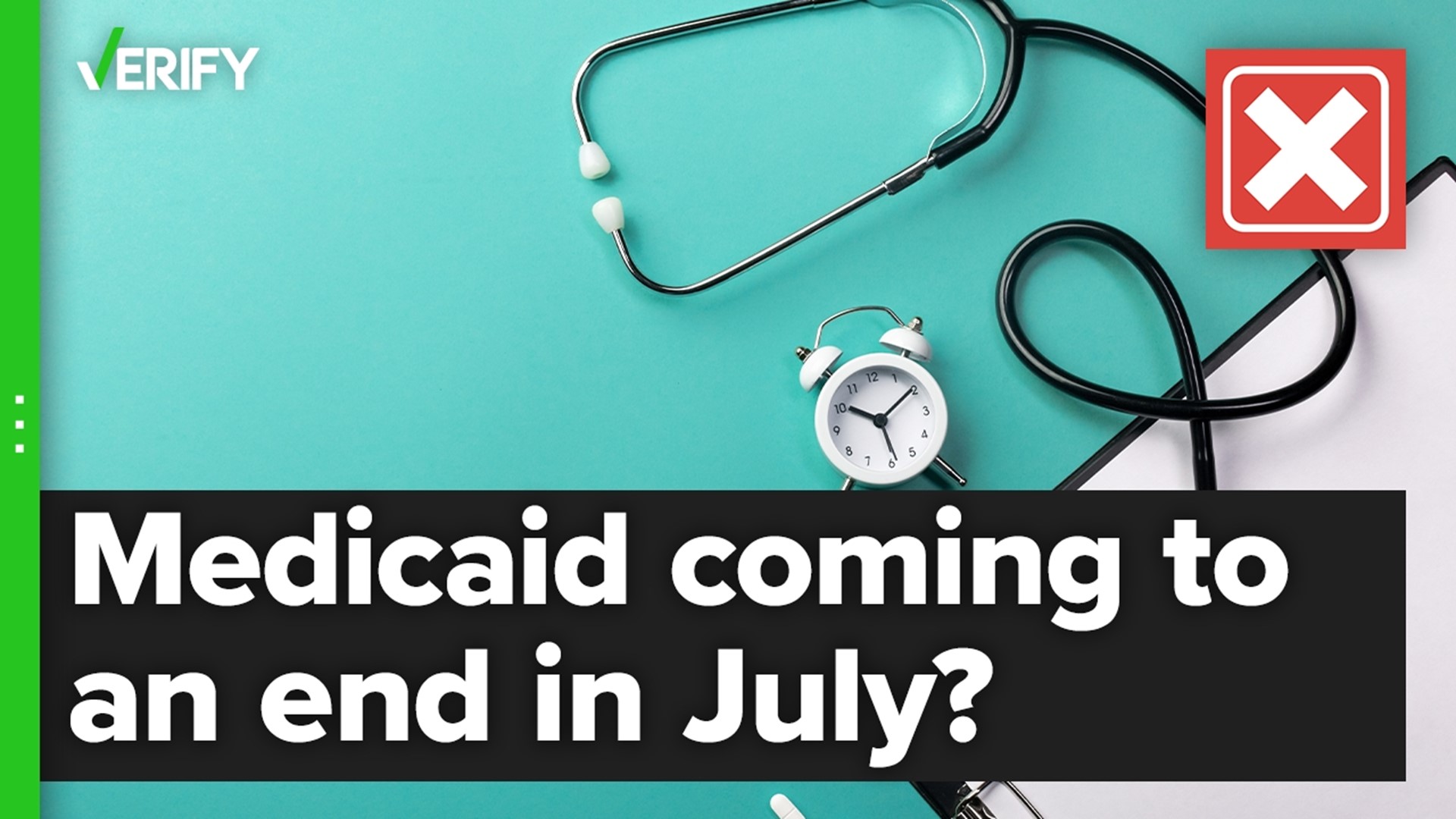A provision of March 2020’s Families First Coronavirus Response Act required states to provide continuous Medicaid coverage to enrollees until the end of the COVID-19 public health emergency in order to receive increased federal funding for Medicaid. That meant states weren’t allowed to terminate a person’s Medicaid coverage during the pandemic, even if they would have otherwise become ineligible.
As federal pandemic programs start to phase out, some are wondering what’s going to happen to Medicaid, a government program that provides free or low-cost health coverage to eligible Americans, primarily people with low incomes. VERIFY reader Thomas texted: “Is Medicaid coming to an end in July?”
THE QUESTION
Will Medicaid coverage come to an end in July?
THE SOURCES
- Department of Health and Human Services (HHS)
- The Commonwealth Fund, a nonprofit with a focus on healthcare policy
- Center on Budget and Policy Priorities (CBPP), a nonpartisan research and policy institute
- Kaiser Family Foundation, a nonprofit organization focusing on national health issues
- Urban Institute, a nonprofit research organization focused on advancing upward mobility and equity
THE ANSWER
No, Medicaid coverage will not come to an end in July. However, once the COVID-19 public health emergency ends, millions could be disenrolled from Medicaid as states redetermine who is eligible for Medicaid.
WHAT WE FOUND
Effective March 18, 2020, at the start of the coronavirus pandemic, every state was forbidden from disenrolling people from Medicaid for reasons other than a covered individual’s request to be disenrolled or a person moving out of state. In return, states received expanded federal funding for their Medicaid programs.
The rule expires at the end of the month in which the COVID-19 public health emergency, which gives HHS additional powers and funding to respond to a health crisis, ends. HHS last extended the public health emergency on April 16, and each renewal extends the emergency by another 90 days. That means the current extension would end on July 15.
But HHS has indicated that it will give states a 60 days notice prior to the end of the public health emergency. May 16, the deadline for a July 15 end date, passed without any such notice.
Once the public health emergency ends, states will begin to redetermine the eligibility for people enrolled in Medicaid, according to a September 2021 blog post for The Commonwealth Fund and a March 2022 blog post for the Center on Budget and Policy Priorities (CBPP). HHS has given states 14 months to complete reenrollment.
A September 2021 Urban Institute report estimated that states could disenroll as many as 15 million people during that period. That’s because some people who became eligible during the public health emergency will be ineligible by the start of the redetermination process because of an increase in income, some people who are eligible will be disenrolled because of administrative issues and because “churn” will return.
Churning, HHS says, occurs when people lose Medicaid and then re-enroll within a short period of time. Without the redetermination process, there is little churn. Churn is caused by Medicaid agencies disenrolling people for temporary increases in income that last less than a few months, and because eligible people are frequently disenrolled because of administrative issues.
A person who still qualifies for Medicaid could lose their coverage during this process because they don’t receive notices from the Medicaid agency, don’t submit required documents on time or because the Medicaid agency is unable to process renewal paperwork on a timely basis, the CBPP said. The sheer number of people who will enter the redetermination process will likely place a stress on Medicaid agencies that could exacerbate these kinds of errors.
“Upon conclusion of the public health emergency, normal state Medicaid operations will resume, including eligibility redetermination,” HHS said in an April 2021 issue brief. “This will represent a substantial and unprecedented undertaking for Medicaid programs, with the potential for significant coverage losses and disruptions.”
People who have Medicaid won’t all lose their coverage the day the public health emergency ends. The Centers for Medicare and Medicaid Services (CMS) has urged states to gradually work through its eligibility redetermination caseload over the course of the allotted time period. Even once a Medicaid agency determines it needs more information from an individual or determines an individual to be ineligible, the enrollee will remain on Medicaid until their deadline to submit documents has passed. That deadline is 10 days at minimum, but CMS has suggested states give individuals 30 days.
A Kaiser Family Foundation survey published in March found that 48 states had established timelines for processing redetermination caseloads. Of those 48 states, 41 states planned to take 9-12 months, four states planned to take 6-9 months and three states planned to take 3-6 months. The Kaiser Family Foundation said states that take less than a full year to complete this process could trigger greater coverage losses because they will have less time to conduct outreach and boost administrative staff capacity.
The Urban Institute estimated that one-third of adults who will lose Medicaid eligibility after the public health emergency ends could qualify for subsidized private health coverage. Nearly all of the remainder, the Urban Institute said, would likely have access to an offer of employer coverage in their family deemed affordable under the Affordable Care Act. People disenrolled from Medicaid enter a special enrollment period to change healthcare plans.
Anyone disenrolled from Medicaid despite remaining eligible can appeal their disenrollment or reapply for Medicaid immediately.
Versión en español: No, la cobertura de Medicaid no terminará en Julio
More from VERIFY: Yes, eligible Americans need to apply for a federal program to get discounted internet service

